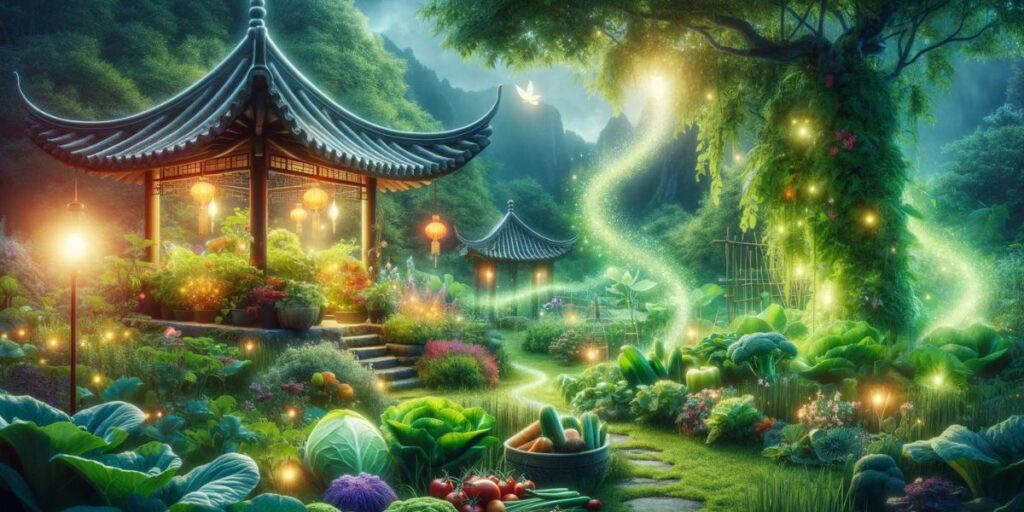
Feng Shui, an ancient Chinese art, is all about creating harmonious surroundings that enhance the balance of yin and yang. When applied to gardening, Feng Shui focuses on arranging the natural landscape to promote a beneficial flow of chi (life energy), thereby fostering well-being, prosperity, and harmony. Let’s look at some key principles for incorporating Feng Shui into your garden.
Five Elements
Feng Shui emphasizes the balance of the five elements: wood, fire, earth, metal, and water. In your garden, this could mean you have wooden planters (wood), a barbecue or red flowers (fire), clay pots or yellow flowers (earth), metal sculptures or white flowers (metal), and a pond or fountain (water). Many items that you already have can be incorporated into you garden design.
Yin and Yang Balance
Achieving a balance between yin (calm, shaded areas) and yang (bright, sunny areas) is crucial. Your garden should have a mix of both – sunny spots for growing and relaxing, and shaded areas for contemplation and cooling off.
Curved Pathways
In Feng Shui, straight lines are thought to speed up the flow of energy, while curved paths slow it down and allow for a more natural, meandering flow of chi.
Water Features
Water is highly valued in Feng Shui for its ability to attract good fortune and wealth. Consider adding a pond, fountain, or birdbath, but make sure the water is clean and flows gently. No wants to be breeding mosquitos!!
Use of Plants
Plants play a significant role in Feng Shui. They are used not only for aesthetic purposes but also to correct Feng Shui imbalances. For example, thorny plants like roses are best placed at the boundaries of a property for protection, while fruit-bearing plants can symbolize abundance. Who doesn’t feel abundant when bringing in a basket of berries?
Garden Placement and Sector Energies
The location of your garden can also be guided by the Bagua map, a Feng Shui tool that aligns spatial areas with aspects of life. For instance, the southeast sector is associated with wealth and prosperity, making it an ideal spot for a vibrant heritage flower garden or a yummy heirloom vegetable patch. It is a good idea to refer to the map and add items into areas that you want to activate.
Colors and Shapes
Colours in Feng Shui may be used to enhance specific energies. For example, red flowers can stimulate energy and passion, while blue or purple can be calming and spiritual. The shapes of plants and garden décor should also complement the Feng Shui element they represent.
Maintenance and Clutter-Free Space
Keeping your garden well-maintained and clutter-free is essential in Feng Shui. Dead plants, clutter, and unused items can block the flow of chi and should be cleared out. I wonder what that means for the weeds?!
Creating a Sanctuary
Ultimately, your garden should be a place of refuge and relaxation. Adding personal touches that make you feel at peace, like a comfortable seating area or a statue that has personal significance, can enhance this energy.
By applying these Feng Shui principles, your garden can become more than just a space for plants and food security; it can transform into a nurturing sanctuary that supports your health and well-being .
Step-by-Step Guide to Creating a Feng Shui Garden
- Understand the Basics of Feng Shui: Familiarize yourself with the core principles of Feng Shui, such as the five elements (wood, fire, earth, metal, water) and the concept of chi (energy flow).
- Plan Your Garden Layout: Start with a clear plan. Consider the Bagua map to identify areas of your garden that correspond to different aspects of life (like wealth, health, family). Plan for a balance of both yin (calm, shady) and yang (bright, sunny) areas.
- Incorporate the Five Elements:
- Wood: Include plants and trees, or wooden furniture.
- Fire: Add elements of red, orange, or pink, possibly through heirloom flowers or garden art.
- Earth: Utilize rocks, clay pots, or yellow and brown colors in plants or decorations.
- Metal: Incorporate metal sculptures, furniture, or garden features like wind chimes.
- Water: Add a water feature such as a fountain or pond.
- Create Curved Pathways: Avoid straight lines which are seen as too harsh in Feng Shui. Opt for winding paths to encourage a gentle, meandering flow of chi.
- Select Plants Wisely: Choose plants that are healthy and appropriate for your climate. Fruit-bearing plants symbolize abundance, while flowering plants add color and vitality.
- Add a Water Feature: If space allows, a small pond or fountain can enhance the sense of calm and bring in prosperity. Make sure the water is clean and flows gently.
- Balance Yin and Yang: Create shaded areas for relaxation (yin) and brighter areas for active growth (yang). This can be achieved with tree placement, pergolas, or sunnier spots for a heirloom vegetable patch.
- Integrate Seating Areas: Place seating areas where you can relax and enjoy the beauty and harmony of your garden.
- Maintain Your Garden: Regular maintenance ensures the healthy flow of chi. Remove clutter, dead plants, and keep the area tidy.
- Personalize Your Space: Finally, add personal touches that make your garden feel like a sanctuary. This could be a particular plant you love, a piece of garden art, or a special seat where you can sit and reflect.
The key to a Feng Shui garden is balance and harmony. It’s not just about following rules but about creating a space that resonates with you and enhances your feelings of well-being.

